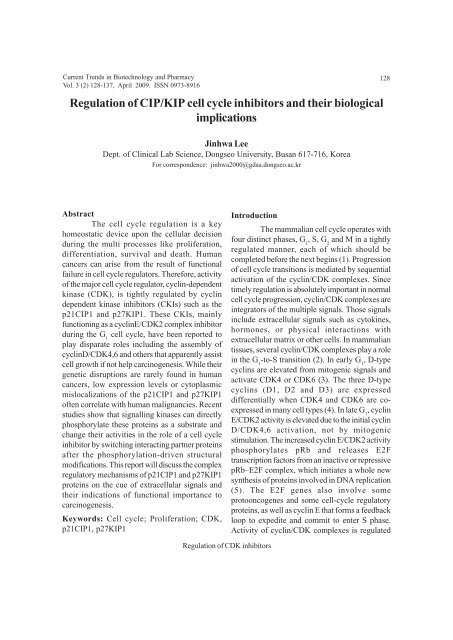April Journal-2009.p65 - Association of Biotechnology and Pharmacy
April Journal-2009.p65 - Association of Biotechnology and Pharmacy
April Journal-2009.p65 - Association of Biotechnology and Pharmacy
You also want an ePaper? Increase the reach of your titles
YUMPU automatically turns print PDFs into web optimized ePapers that Google loves.
Current Trends in <strong>Biotechnology</strong> <strong>and</strong> <strong>Pharmacy</strong><br />
Vol. 3 (2) 128-137, <strong>April</strong> 2009. ISSN 0973-8916<br />
Regulation <strong>of</strong> CIP/KIP cell cycle inhibitors <strong>and</strong> their biological<br />
implications<br />
128<br />
Jinhwa Lee<br />
Dept. <strong>of</strong> Clinical Lab Science, Dongseo University, Busan 617-716, Korea<br />
For correspondence: jinhwa2000@gdsu.dongseo.ac.kr<br />
Abstract<br />
The cell cycle regulation is a key<br />
homeostatic device upon the cellular decision<br />
during the multi processes like proliferation,<br />
differentiation, survival <strong>and</strong> death. Human<br />
cancers can arise from the result <strong>of</strong> functional<br />
failure in cell cycle regulators. Therefore, activity<br />
<strong>of</strong> the major cell cycle regulator, cyclin-dependent<br />
kinase (CDK), is tightly regulated by cyclin<br />
dependent kinase inhibitors (CKIs) such as the<br />
p21CIP1 <strong>and</strong> p27KIP1. These CKIs, mainly<br />
functioning as a cyclinE/CDK2 complex inhibitor<br />
during the G 1<br />
cell cycle, have been reported to<br />
play disparate roles including the assembly <strong>of</strong><br />
cyclinD/CDK4,6 <strong>and</strong> others that apparently assist<br />
cell growth if not help carcinogenesis. While their<br />
genetic disruptions are rarely found in human<br />
cancers, low expression levels or cytoplasmic<br />
mislocalizations <strong>of</strong> the p21CIP1 <strong>and</strong> p27KIP1<br />
<strong>of</strong>ten correlate with human malignancies. Recent<br />
studies show that signalling kinases can directly<br />
phosphorylate these proteins as a substrate <strong>and</strong><br />
change their activities in the role <strong>of</strong> a cell cycle<br />
inhibitor by switching interacting partner proteins<br />
after the phosphorylation-driven structural<br />
modifications. This report will discuss the complex<br />
regulatory mechanisms <strong>of</strong> p21CIP1 <strong>and</strong> p27KIP1<br />
proteins on the cue <strong>of</strong> extracellular signals <strong>and</strong><br />
their indications <strong>of</strong> functional importance to<br />
carcinogenesis.<br />
Keywords: Cell cycle; Proliferation; CDK,<br />
p21CIP1, p27KIP1<br />
Introduction<br />
The mammalian cell cycle operates with<br />
four distinct phases, G 1<br />
, S, G 2<br />
<strong>and</strong> M in a tightly<br />
regulated manner, each <strong>of</strong> which should be<br />
completed before the next begins (1). Progression<br />
<strong>of</strong> cell cycle transitions is mediated by sequential<br />
activation <strong>of</strong> the cyclin/CDK complexes. Since<br />
timely regulation is absolutely important in normal<br />
cell cycle progression, cyclin/CDK complexes are<br />
integrators <strong>of</strong> the multiple signals. Those signals<br />
include extracellular signals such as cytokines,<br />
hormones, or physical interactions with<br />
extracellular matrix or other cells. In mammalian<br />
tissues, several cyclin/CDK complexes play a role<br />
in the G 1<br />
-to-S transition (2). In early G 1<br />
, D-type<br />
cyclins are elevated from mitogenic signals <strong>and</strong><br />
activate CDK4 or CDK6 (3). The three D-type<br />
cyclins (D1, D2 <strong>and</strong> D3) are expressed<br />
differentially when CDK4 <strong>and</strong> CDK6 are coexpressed<br />
in many cell types (4). In late G 1<br />
, cyclin<br />
E/CDK2 activity is elevated due to the initial cyclin<br />
D/CDK4,6 activation, not by mitogenic<br />
stimulation. The increased cyclin E/CDK2 activity<br />
phosphorylates pRb <strong>and</strong> releases E2F<br />
transcription factors from an inactive or repressive<br />
pRb–E2F complex, which initiates a whole new<br />
synthesis <strong>of</strong> proteins involved in DNA replication<br />
(5). The E2F genes also involve some<br />
protooncogenes <strong>and</strong> some cell-cycle regulatory<br />
proteins, as well as cyclin E that forms a feedback<br />
loop to expedite <strong>and</strong> commit to enter S phase.<br />
Activity <strong>of</strong> cyclin/CDK complexes is regulated<br />
Regulation <strong>of</strong> CDK inhibitors













